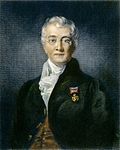File:Watercolour, wounded soldier at Waterloo Wellcome L0022548.jpg

Original file (5,036 × 3,552 pixels, file size: 7.14 MB, MIME type: image/jpeg)
Captions
Captions
Summary edit
| Charles Bell: Watercolour, wounded soldier at Waterloo
( |
||||||||||||||||||||||||
|---|---|---|---|---|---|---|---|---|---|---|---|---|---|---|---|---|---|---|---|---|---|---|---|---|
| Artist |
artist QS:P170,Q451727 |
|||||||||||||||||||||||
| Title |
Watercolour, wounded soldier at Waterloo |
|||||||||||||||||||||||
| Description |
Soldier suffering from head wound {and shock?}, inscribed "Waterloo...". This is one of a series of watercolours by the surgeon Charles Bell (1774-1842) of wounded soldiers from the battle of Waterloo. Bell had hurried from London to Brussels in June 1815 to assist in treating the wounded; at the same time he filled a sketchbook with interesting cases which were subsequently worked up as watercolour paintings for teaching purposes. This man had received a very serious gunshot wound to the skull, causing extrusion of brain tissue. The picture clearly shows the cross-shaped surgical cut of the skin around the wound, made in order to remove damaged bone fragments. Unfortunately such an injury provided an avenue for infection of the central nervous system which surgeons at the time were powerless to prevent. Sure enough this patient died six days after Bell sketched him. His staring eyes and flushed appearance are indicative of meningeal irritation, or inflammation of the lining of the brain. Archives & Manuscripts |
|||||||||||||||||||||||
| Credit line |
|
|||||||||||||||||||||||
| References |
|
|||||||||||||||||||||||
| Source/Photographer |
https://wellcomeimages.org/indexplus/obf_images/df/20/6651c497f7d68aebd5ace15b32fd.jpg |
|||||||||||||||||||||||
Licensing edit
| Public domainPublic domainfalsefalse |
|
The author died in 1842, so this work is in the public domain in its country of origin and other countries and areas where the copyright term is the author's life plus 100 years or fewer. This work is in the public domain in the United States because it was published (or registered with the U.S. Copyright Office) before January 1, 1929. | |
| This file has been identified as being free of known restrictions under copyright law, including all related and neighboring rights. | |
https://creativecommons.org/publicdomain/mark/1.0/PDMCreative Commons Public Domain Mark 1.0falsefalse
File history
Click on a date/time to view the file as it appeared at that time.
| Date/Time | Thumbnail | Dimensions | User | Comment | |
|---|---|---|---|---|---|
| current | 03:17, 9 October 2014 |  | 5,036 × 3,552 (7.14 MB) | Fæ (talk | contribs) | =={{int:filedesc}}== {{Artwork |artist = |author = |title = Watercolour, wounded soldier at Waterloo |description = Soldier suffering from head wound {and shock?}, inscribed "Waterloo...". This is one of... |
You cannot overwrite this file.
File usage on Commons
The following page uses this file:
Metadata
This file contains additional information such as Exif metadata which may have been added by the digital camera, scanner, or software program used to create or digitize it. If the file has been modified from its original state, some details such as the timestamp may not fully reflect those of the original file. The timestamp is only as accurate as the clock in the camera, and it may be completely wrong.
| Short title | L0022548 Watercolour, wounded soldier at Waterloo |
|---|---|
| Author | Wellcome Library, London |
| Headline | L0022548 Watercolour, wounded soldier at Waterloo |
| Copyright holder | Copyrighted work available under Creative Commons Attribution only licence CC BY 4.0 http://creativecommons.org/licenses/by/4.0/ |
| Image title | L0022548 Watercolour, wounded soldier at Waterloo
Credit: Wellcome Library, London. Wellcome Images images@wellcome.ac.uk http://wellcomeimages.org Soldier suffering from head wound {and shock?}, inscribed "Waterloo...". This is one of a series of watercolours by the surgeon Charles Bell (1774-1842) of wounded soldiers from the battle of Waterloo. Bell had hurried from London to Brussels in June 1815 to assist in treating the wounded; at the same time he filled a sketchbook with interesting cases which were subsequently worked up as watercolour paintings for teaching purposes. This man had received a very serious gunshot wound to the skull, causing extrusion of brain tissue. The picture clearly shows the cross-shaped surgical cut of the skin around the wound, made in order to remove damaged bone fragments. Unfortunately such an injury provided an avenue for infection of the central nervous system which surgeons at the time were powerless to prevent. Sure enough this patient died six days after Bell sketched him. His staring eyes and flushed appearance are indicative of meningeal irritation, or inflammation of the lining of the brain. Watercolour 1815 By: Charles BellPublished: - Copyrighted work available under Creative Commons Attribution only licence CC BY 4.0 http://creativecommons.org/licenses/by/4.0/ |
| IIM version | 2 |

